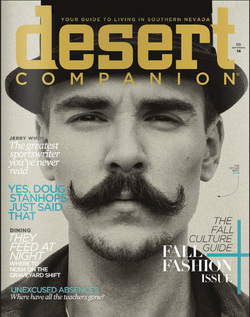| Desert Companion September 2014 | Desert Companion’s Fall Culture Issue is out and it directly challenges Las Vegas art and artists. Editor Andrew Kiraly boldly opens with “The job of the artist isn’t just to make art, it’s to make the audience.” Inside, Misti Yang’s op-ed "Paint it lack" is ready to declare Las Vegas is a post-museum city, while pointing to the Neon Museum as a rare success because it celebrates the “mythos of Las Vegas.” Yang’s goes on to share an idea. If Las Vegas is indeed a post-museum city, an art institution could serve the city better by fostering temporary installations from local and international artists. I’m for that. It allows the varied forms of public art, including murals and street art, to be vital. Paint on walls or sculptures in empty parcels by local and visiting artists can work as semi-permanent or pop-up cultural way finders, which is crucial in a city with stalled gallery support and the sputtering starts and stops of museums. The art-on-the street experience can also mirror the outdoor spectacle the region is known for. I also brought up the concept of pop-up installations with some members of the local art community earlier in the year. During the planning of Main Street Improvements, a projects that highlights the 18b arts district and City Hall as destinations, I asked if it was an opportunity to increase utilities that could power pop-up work. They can have the spirit of Justin Favela’s commentary, or new concepts by long-time local artists who create temporary lit sculpture interpret their city. It can also be a way to increase art activity that isn’t burdened with the same bureaucracy as permanent public art. Yet, the same op-ed that talks of bringing in outside artists as being part of the solution also brings up the familiar mindset: Damn those outsiders who come into town and tell us what to think. “Las Vegas may or may not be many things, but we are definitely wary of outsiders who presume they know what will make us better, smarter or more respectable,” Yang wrote. I’m empathetic of that in many ways. As an artist and writer in Los Angeles who still covers that city I see new arrivals ready to redefine the city with their interpretation. It takes a band of locals, including artists and historians, to counter that with weighty regional narrative in their work. And they do it with curated ideas without blind boosterish motives. But speaking as an “outsider” with a few years residency, I can also say something unique happens here. Some of us came to Las Vegas wary of a town that considers any non-native (or someone who wasn’t around during the 1980s) a tourist unless they earn major residency points. With the population of Las Vegas in 1994 at 336,380, then jumping to 596,424 in 2012, according to U.S. Census, that’s a lot of “tourists” who have certain expectations when they dig new roots in a city. Still, that prompted me to take more time to survey the art community to really understand the subtext of Las Vegas. One of the first people to extend his hand was Desert Companion editor Andrew Kiraly, who asked me what I thought of Las Vegas public art. “It doesn’t suck as much as one would expect,” I said in March. And it doesn’t. There's good work being created around the Valley. What's exciting is Las Vegas is still a blank canvas for public artists to define the city with satire or affection. And as Kiraly suggests, an artists’ job is also about creating an audience. Las Vegas isn’t a hole that swallows up artists. With social networking, a global audience can be found and the streets are a major gallery waiting for new works. |
Worth exploring
- Casinos Not On Gamstop
- Casinos Not On Gamstop
- Mejores Casinos Online
- Non Gamstop Casino
- Online Casinos UK
- Non Gamstop Casino Sites UK
- Sites Not On Gamstop
- Best Online Casino Canada
- Non Gamstop Casinos
- オンラインカジノ
- Non Gamstop Casino
- Mejores Casas De Apuestas Deportivas
- Non Gamstop Casinos UK
- Siti Scommesse
- Siti Per Scommesse
- Lista Casino Online Non Aams
- Casino En Ligne Fiable
- Casinos Not On Gamstop
- UK Online Casinos Not On Gamstop
- UK Online Casinos Not On Gamstop
- Gambling Sites Not On Gamstop
- Meilleur Casino En Ligne
- Non Gamstop Casino
- Migliore Casino Non Aams
- Casino Online
- Casino En Ligne Belgique Liste
- Crazy Time Live Bonus
- Top Nhà Cái Uy Tín
- зарубежные казино
- Casino Cresus
|
Comments are closed.
|
TAGS
All
ARCHIVES
May 2016
|


 RSS Feed
RSS Feed

